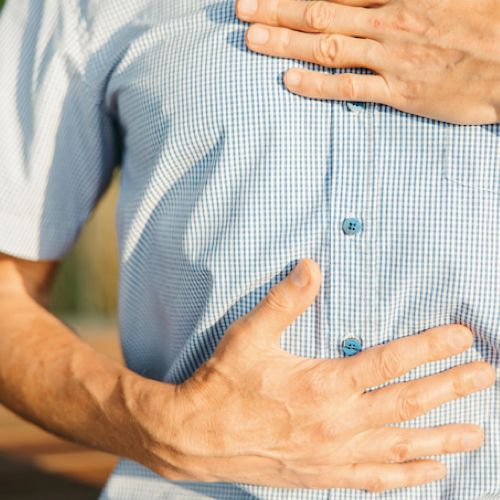What is Stomach Cancer?
Stomach cancer is a type of cancer that occurs as a result of uncontrolled growth and proliferation of cells surrounding the stomach.
While the incidence of stomach cancer is gradually decreasing, it continues to maintain its severity because it is a partially preventable disease. With the scientific researches on stomach cancer, serious developments have been made in order to prevent cancer before it starts. One of the causes of stomach cancer is the presence of a bacterium called Helicobacter pylori and the treatment of the bacterium with antibiotic drugs, has an important place in the fight against stomach cancer. At this point, there are doubts that the eradication of Helicobacter pylori, that is, its disappearance with antibiotic drugs, will prevent gastric cancer. This bacterium can also lead to different diseases such as lymphoma.
Types of Stomach Cancer
Gastric cancer is examined in some subgroups according to the region where the cancer is seen. Among them, adenocarcinoma is the most common type of stomach cancer. However, squamous cell carcinoma, gastric lymphoma, gastrointestinal stromal tumor, carcinoid tumor, small cell carcinoma and leiomyosarcoma are also among the types of gastric cancer.
What Cause Stomach Cancer?
In the emergence of gastric cancer, besides genetic factors, there are environmental reasons and different diseases that pave the way for the formation of cancer. Cases with a family history take up very little place among all cases. In addition to factors such as Helicobacter pylori, hereditary causes, nutrition, some different factors or protective agents may also play a role in the development of cancer. In some occupational groups, the incidence is higher. For example, the incidence of gastric cancer is slightly higher in coal mine workers, asbestos and rubber workers, and in those working in the petrochemical and tire production sectors.
Stomach Cancer Risk Factors
The stomach is exposed to an amount of bile and pancreatic secretion above the normal level in those who have stomach disease and who have undergone treatment related to it, and the risk of developing stomach cancer in these patients is higher than in other individuals. Apart from this, the risk of stomach cancer increases considerably in individuals who consume cigarettes and excessive smoking at a young age. Apart from all these, factors such as heavily salted brine, fermented soy, some food preservatives, high-temperature red meat, moldy foods, fried foods and excessive consumption of red meat are also the triggers of stomach cancer.
What are the Symptoms of Stomach Cancer?
Like many types of cancer, stomach cancer, which grows insidiously, is usually at an advanced stage when it shows symptoms. On the other hand, even if it shows symptoms, some of them are ignored by individuals because they overlap with other diseases.
Among the symptoms of stomach cancer, factors such as unexplained weight loss, pain in the abdomen, nausea, vomiting, loss of appetite, unexplained bleeding, difficulty in swallowing, early satiety, and ulcer-like pain can be listed.
Where do you feel stomach cancer pain?
Stomach cancer has many symptoms. One of them is nausea and difficulty swallowing. Abdominal pain occurs. This pain is felt around the stomach and pain may be felt under the breastbone.
How Is Stomach Cancer Diagnosed?
The method of detecting cancer in an individual without symptoms is through screening tests.
Medical History and Physical Examination in Stomach Cancer
If you suspect stomach cancer, your doctor will examine you and listen to your family history. He or she will ask relevant questions and try to detect abnormal situations. Because of this application is quite insufficient, different tests and examinations will be requested
Tests to Detect Stomach Cancer
In the application called endoscopy, a tube with a video camera at the end is inserted into the patient’s mouth and imaging is performed. As the tube progresses, images of the stomach are examined. If an abnormal situation is encountered, sample tissue can be taken. The process of taking sample tissue is called biopsy. Tissues taken from the suspicious region are examined in the pathology laboratory to determine the characteristics of the tumor.
In the endoscopic ultrasound application, a sound wave is used to visualize the stomach. In this application, a probe is inserted through the mouth. Structures outside the stomach may also be visualized. A device that takes pictures from different angles is used in computed tomography. Regions where cancer may spread can also be viewed by combining the samples taken from the target region. Magnetic resonance imaging, on the other hand, gives cross-sectional images like computed tomography, but here strong magnets are used instead of X-rays.
In the positron emission tomography (PET) method, a radioactive substance is given intravenously to the patient and that substance is expected to collect in cancerous regions. Afterwards, images are collected with special cameras and information is obtained in terms of the whole body. With a chest X-ray, it can be checked whether the cancer has spread to the lung. With the laparoscopy application, knowing the extent of the spread after the diagnosis will be useful in the treatment process. Hard-to-reach regions can be visualized by inserting a tube camera by cutting the abdomen.
With complete blood count tests, information about many factors related to the body can be obtained. With the blood chemistry test, it can be observed whether there are cancerous cells in the liver. Detection can be made with a fecal occult blood test.
How is Stomach Cancer treated?
Surgical intervention
If the cancer has not developed too far and your health condition is suitable, the first surgery is started. Depending on the extent of the disease and histological subtype, total or subtotal, that is, all or a part of the stomach is removed together with the surrounding lymph nodes. While applying the surgical method, it is necessary to mention the concepts of D1 and D2 dissection. If there is a limited surgical procedure at this point, it is called D1. Despite the increasing number of D2 dissections, there is generally a D1 dissection practice. At this point, it has been proven by the recent studies that D2 dissection is curative and its contribution to survival is undeniably effective. Palliative surgeries can also be performed to prevent bleeding and stomach obstruction.
In tumors located in the first part of the stomach, which we call cardia, it is necessary to start with chemotherapy or radiochemotherapy if it is an advanced stage tumor before surgery.
When you are diagnosed with stomach cancer, getting an opinion from a Radiation Oncologist or Medical Oncologist before starting the treatment will ensure that you are directed to the treatment in the most appropriate way.
Radiotherapy
Radiotherapy, also called radiation therapy, is the process of using high-energy rays to destroy a tumor. It can facilitate the operation by minimizing the tumor together with chemotherapy before the operation. However, it can also be used to kill residual cells after surgery. Pre-surgical radiotherapy and chemotherapy are becoming increasingly important in cancers involving the stomach and the stomach entrance of the esophagus. Radiotherapy can slow the progression of cancer in patients who cannot be given other treatment due to poor general condition, increase the life quality and save time for the patient. Likewise, since radiotherapy may increase the effect of immunotherapy in patients undergoing immunotherapy, we recommend that each of our patients who are at the stage of diagnosis and deciding on treatment should receive opinions from each of the surgeons, radiation oncology and medical oncology departments.
Chemotherapy
In the treatment aimed to kill cancer cells, intravenous or oral drugs are given. Medicines that are directly included in the circulatory system offer a more effective solution. This treatment, which can also be used for shrinking the tumor, can also be applied for cleaning the cells that are considered as post-surgical residues. It is used to improve the quality of life and minimize symptoms in patients with advanced stages. It is a treatment given in the form of cures, considering the general condition of the patient.
HER2 Receptor
It is a receptor located on the cell membrane surface and belongs to the epidermal growth factor family. At this point, with the targeted treatments used, the HER2 algae is bound to prevent it from interacting with other receptors, and the cancerous cell is also marked. In this way, the defense can recognize and destroy cells.
VEGF Way
Cancerous cells need nutrients and oxygen to grow. The cancerous mass forms a blood vessel over the vascular growth factor receptor. It also shows symptoms of developing. The drugs developed at this point prevent the developments of the tumor by disrupting the vascular structures.
Immunotherapy
In this type of treatment, the immune system can be triggered to better identify cancerous cells and fight them more effectively. Many methods are used in immunotherapy, which is one of the important inventions today. T lymphocytes, a valuable cell of the defense, contain a protein called PD1. Cancer cells increase the amount of the protein called PDL1, allowing T lymphocytes to communicate with PD1. In this way, T cells become inactive. Cancerous cells are not perceived as foreign in this way. Immunotherapeutic agents inhibit this association.
Microsatellite Instability
It is the condition of DNA mismatch repair deficiency and genomic instability in the DNA mismatch process. Genomic instability occurs because DNA mismatches cannot be repaired in desired degree.
Cases of tumors with microsatellite instability (MSI-H) are too numerous to be underestimated. Detecting these tumors is of great importance as tumors respond effectively to immunotherapy drugs but less responsive to chemotherapy. It is also possible in the near future that tumors will be classified according to whether they are MSI positive or negative.
How to Prevent Stomach Cancer?
In order to prevent stomach cancer, adequate and regular nutrition is the most important issue that needs attention. It will be protective to stay away from food and drinks that are not good for us, as they will cause us to feel unwell, bloating or pain immediately after eating them. In order not to increase reflux, it is necessary not to lie down after meals, to sleep with a high pillow if there is already a reflux problem, and to avoid acidic and salty foods.
Stomach Cancer Prevention Ways
- Staying away from cancer-causing substances such as cigarettes and alcohol
- Eating healthy and properly
- Reducing salt intake
- Not reusing frying oil

